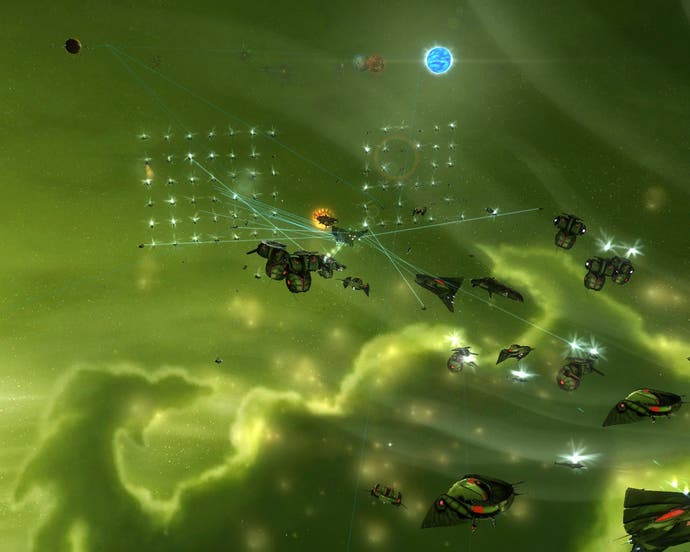Sins of a Solar Empire
Why not be a dirty sinner?
The bits where you order a fleet of a hundred or so cruisers, frigates and capital ships to line up in an epic formation at the edge of a solar system, and jump simultaneously to a neighbouring solar system? Where dozens of portals open up, and your vessels accelerate through them trailing hyperbright lights? Wicked. When you get a mob of Siege Frigates in orbit above a populated world and giggle as the planet's surface blossoms in what you have to presume to be nuclear detonations? Awesome. And when an enemy fleet appears in your solar system, and a dozen fighter and bomber wings take off, closing the distance to the incoming ships while your big boys ponderously manouevre to join in? Hell yeah!
It's worthwhile to take a little time out to be shallow, because there's going to be precious little opportunity for that as we go on. Sins of a Solar Empire - and can we take a moment to applaud the name, too? - is a space-strategy epic whose stately games stretch out as large as the canvas of space itself. With such an epic game, so rich in mechanisms and with flashes of genuine innovation, how well it puts you in the enormous metal boots of a space conquerer can be overlooked in a rush to just get the fact downs. But, take it as read, if you've ever fantasised about leading a fleet to annihilate a planet full of everyone who's ever looked at you funny, this one's for you. And probably for people with a less vengefully sociopathic streak of space-emperor fantasy too.

While it's from Ironclad, made up primarily of veterans of the Homeworld: Cataclysm team, the easiest way to describe Sins of a Solar Empire is to take publisher Stardock's previous game, Galactic Civilizations 2, and imagine it in real time. It's reduced, clearly, to save human brains liquidising under the strain, but there are parallels to almost everything you'd get up to in GalCiv. At the start, the map is hidden beneath a fog, forcing you to explore. Out there, you'll locate planets and asteroids, which can be colonised or otherwise exploited. Each planetary structure gives you a number of slots to fill according to your strategies, weighing up a research base against another space dock, a repair station against a fighter-base. All of these have to be researched, with separate tech-trees for military and production-style bonuses (plus another one for alien artifacts you uncover on your own planets, and another for increasing your maximum fleet size and number of capital ships). More indirect routes to conquering and control are made possible via the broadcast centres spread insidiously across the maps. Diplomacy is wrestled with, and it's possible to forge trade agreements and treaties.
So, a 4X game (Explore, Exploit, Expand, Exterminate, in some order or other), but in real time. It's a neat idea. It could work. And - phew! - it does.
The "real-time" thing may be confusing. This isn't something that moves with the pace of Command & Conquer. Even the small maps are a couple of hours' play. If you want to deal with a multi-star galaxy with ten races looking to be the winner, you're looking at the sort of commitment of time that matches many entire single-player games (or two or three Losts). You can have slower games by reducing the speed, or speed them up instead, but this is a game where the relative ponderousness of what you're controlling is absolutely the point.


